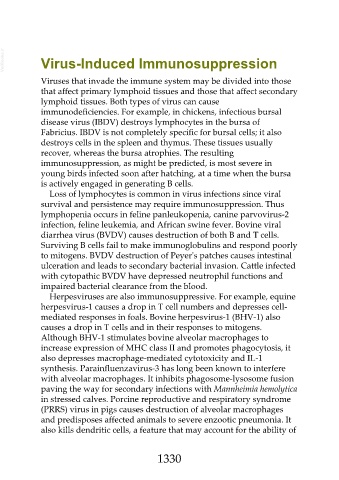Page 1330 - Veterinary Immunology, 10th Edition
P. 1330
VetBooks.ir Virus-Induced Immunosuppression
Viruses that invade the immune system may be divided into those
that affect primary lymphoid tissues and those that affect secondary
lymphoid tissues. Both types of virus can cause
immunodeficiencies. For example, in chickens, infectious bursal
disease virus (IBDV) destroys lymphocytes in the bursa of
Fabricius. IBDV is not completely specific for bursal cells; it also
destroys cells in the spleen and thymus. These tissues usually
recover, whereas the bursa atrophies. The resulting
immunosuppression, as might be predicted, is most severe in
young birds infected soon after hatching, at a time when the bursa
is actively engaged in generating B cells.
Loss of lymphocytes is common in virus infections since viral
survival and persistence may require immunosuppression. Thus
lymphopenia occurs in feline panleukopenia, canine parvovirus-2
infection, feline leukemia, and African swine fever. Bovine viral
diarrhea virus (BVDV) causes destruction of both B and T cells.
Surviving B cells fail to make immunoglobulins and respond poorly
to mitogens. BVDV destruction of Peyer's patches causes intestinal
ulceration and leads to secondary bacterial invasion. Cattle infected
with cytopathic BVDV have depressed neutrophil functions and
impaired bacterial clearance from the blood.
Herpesviruses are also immunosuppressive. For example, equine
herpesvirus-1 causes a drop in T cell numbers and depresses cell-
mediated responses in foals. Bovine herpesvirus-1 (BHV-1) also
causes a drop in T cells and in their responses to mitogens.
Although BHV-1 stimulates bovine alveolar macrophages to
increase expression of MHC class II and promotes phagocytosis, it
also depresses macrophage-mediated cytotoxicity and IL-1
synthesis. Parainfluenzavirus-3 has long been known to interfere
with alveolar macrophages. It inhibits phagosome-lysosome fusion
paving the way for secondary infections with Mannheimia hemolytica
in stressed calves. Porcine reproductive and respiratory syndrome
(PRRS) virus in pigs causes destruction of alveolar macrophages
and predisposes affected animals to severe enzootic pneumonia. It
also kills dendritic cells, a feature that may account for the ability of
1330

